Where to go in Switzerland on a short trip: Alps, lakes, and cities
Switzerland is an extremely popular country for those planning multi-stop tours around Europe, yet very few potential first-time visitors actually know specifically where they want to go. Everyone seems to know that it has the most beautiful views of the Alps and some very impressive cities, but there are actually many misconceptions among casual trip planners, so I’d like to clear most of that up below. The places to visit in Switzerland are not obvious until you’ve been there yourself or done many hours of research, so the list below should be a short cut.
I get hundreds if not thousands of itinerary questions for people who are considering a Eurail trip around Europe, and most people just include the word “Switzerland” among a list of cities like Paris, Rome, and Berlin that they want to visit. So where in Switzerland should you go if you can only make a few stops at most? I’ll answer that question below.
Note: This article was expanded and updated in February, 2024.
Switzerland is about outdoor views rather than city visits
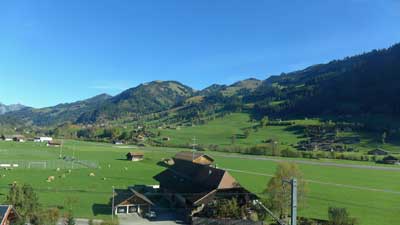
Geneva is a very famous city (though not for tourism reasons) on a lovely lake of the same name, but it’s also notoriously dull and lacking distinction. Rick Steves puts it well by saying that “Geneva is pleasantly situated on a lake, like Buffalo or Cleveland.” The point is, you don’t want to go to Geneva unless you’ve got something specific in mind that you want to see there.
Switzerland's cities in summary
Zurich – The largest city, very expensive, geared towards business travelers. It’s generally a pretty and very well-run city that you would enjoy if you visited, but it’s not nearly as interesting as the likes of Vienna, Munich, or of course Paris.
Geneva – Second largest city, in the French part of the country, no major sights. Again, if you visited you’d be very impressed by it and get some great photos, but it’s not worth your time unless you know someone there. There’s an impressive fountain in the lake and you can usually see it from the train as you go through the city, but it’s not really worth going there and staying more than an hour or so.
Basel – Bordering France and Germany, no major sights. It has the famous art market each year, and aside from that it’s even duller than the ones above. Again, if you visited you’d be impressed, but if you later compared photos with friends who went to the Lauterbrunnen Valley instead, you’d kick yourself for going to Basel.
Lausanne – Near Geneva in the French part of the country, very hilly, and certainly more interesting than Geneva.
Bern – The capital, compact, on a lovely river, some interesting sights and the best Swiss city to get a feel for the culture. Bern is fairly close to Interlaken (which we will discuss below) and it can be a great day trip from there, especially on a day where it is foggy and/or rainy in the mountains (and this happens a LOT).
How much time and which Swiss cities to visit?
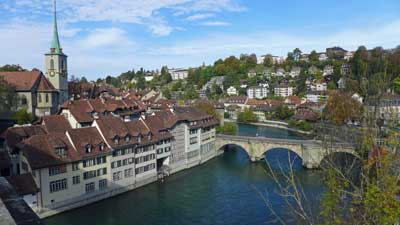
Many people (me included) don’t feel as if they’ve scratched the surface of a new country if they haven’t spent at least a day or two in the largest city. Zurich is certainly pleasant and a useful transit hub so spending one or two nights there wouldn’t be a major mistake. But Zurich isn’t even close to being a city like Paris, Rome, Berlin, Amsterdam, or even Vienna. If you skip it in favor of spending more time in the outdoors, you won’t be missing much.
The 2 Swiss places to focus on for short visits
Interlaken – If you want the best possible Alpine views and activities, head to the Interlaken area, which will be described in detail below.
Lucerne – The traditional Swiss tourist retreat, Lucerne is a small city with interesting culture and sights, that is gorgeously set on a lake with plenty of top activities surrounding it.
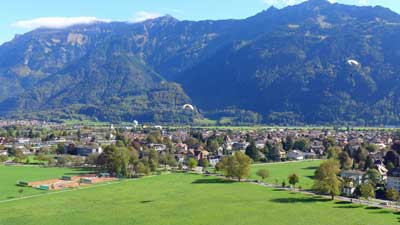
What about Zermatt for Alpine views?
Zermatt is a remote car-free village in southern Switzerland that is famous for being the place to see the Matterhorn mountain. It’s also a busy ski resort area, and aside from that, there isn’t much to see or do here. It’s on a private rail line, so it’s more complicated and usually more expensive to reach than Interlaken.
In other words, unless you’ve irrationally placed “Seeing the Matterhorn in person” on your so-called bucket list, skip Zermatt and head to Interlaken on a shorter visit. You won’t be sorry. If you already have enough time in your visit for the main sights around Interlaken and Lucerne and you want to also see the Matterhorn, then by all means go and you’ll enjoy it. There are quite a few other car-free villages in the Lauterbrunnen Valley near Interlaken, so they are not as novel in Switzerland as one might expect.
A weekend in Switzerland?
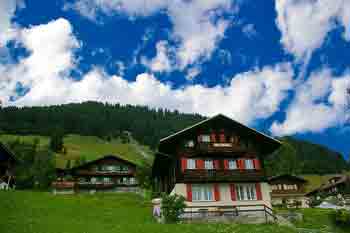
One challenge is that neither has an international airport so you’ll either be flying into Zurich or perhaps Geneva.
Train times from Zurich to Lucerne to Interlaken and back
- Zurich Airport to Lucerne: 1 hour 10 minutes by train
- Lucerne to Interlaken: 2 hours by train
- Interlaken to Zurich Airport: 2 hours 15 minutes by train
As you can see with the travel times above, Zurich Airport to Lucerne is a fairly short trip, but once you add Interlaken into the mix (even if you skip Lucerne) the travel time starts to add up for a weekend visit. With this in mind it’s probably best to just choose one of them and save the other one for another trip.
Lucerne is gorgeous, but the Lauterbrunnen Valley near Interlaken is really the star of the show, so I’d recommend going there first and doing Lucerne on another trip.
What about the Swiss Travel Pass?
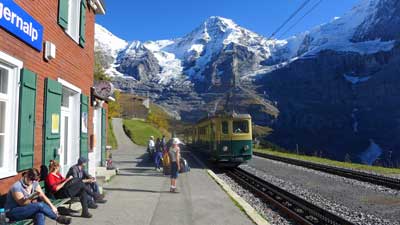
The bottom line is that if you are coming to Switzerland for at least 3 days and you want to take 2 or more of the amazing scenic rail journeys that the country is famous for, the travel pass is probably a good deal. It also provides 50% discounts on the Schilthorn cable car and 25% off the Jungfraujoch mountain railway. Both of those are quite expensive on their own, but extremely worthwhile, so the discount is helpful.
The Half Fare Card is probably a better deal for most people
The Swiss Travel Pass is a good deal for those who are going to be spending at least 2 or 3 days riding the rails and seeing Switzerland that way. But if you are mostly going to be focusing on Interlaken and Lucerne and the mountain sights, the Half Fare Card is the best option. For CHF120 (about US$134) you get the card that is good for 30 days and gives you a 50% discount on all trains, cable cars, mountain railways, and other sights and attractions. If you are doing either Schilthorn or Jungfraujoch, the Half Fare Card practically pays for itself with just one of those.
>>>Buy the Swiss Half Fare Card
Many people have questions about the Swiss Half Fare Card so I will explain it a bit here. You can actually buy half price train tickets for travel within Switzerland any time you want and you will see that option when you go to buy them online. The only thing is you have to have and present a valid Half Fare Card when you get on the train and are asked to see your ticket. In other words, you can buy a half fare train ticket today and buy a Half Fare Card just before you get on that train months in the future, and you are fine.
How and why visit the area around Interlaken
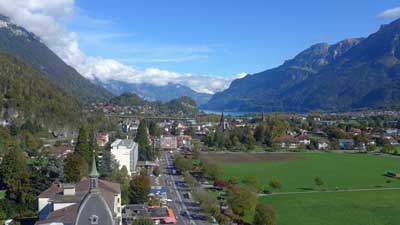
You can see everything discussed below by actually staying in a hotel in Interlaken, but it’s not the Alpine experience that you get if you stay in one of the small villages nearby. You can reach those villages in 20 to 40 minutes from the Interlaken Ost (East) train station, and it’s much easier than it sounds.
The 3 best places to stay to visit the Swiss Alps
Lauterbrunnen – A private train line runs from Interlaken Ost station to the end of its line in Lauterbrunnen. There’s a lovely waterfall here and great hiking trails, but you should probably only stay here if you can’t get to one of the villages mentioned just below. It’s a great little transit hub and it’s definitely gorgeous, so it can be worth a night if you’ve got one to spare.
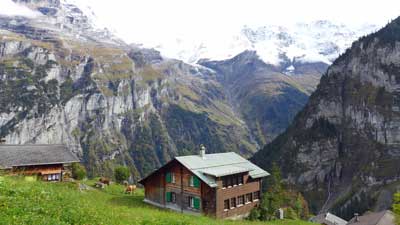
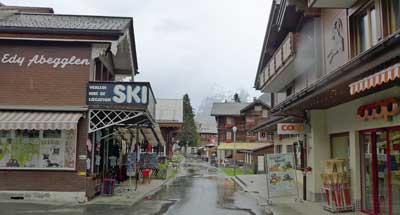
Where to stay in Interlaken and the Lauterbrunnen Valley (with pics)
I get so many questions about where to stay in the Interlaken area that I decided to write a longer version of it and load it with huge photos so readers can get a better feel for each option. I also included recommendations for affordable and well-located photos in each area.
>>>Where to stay in Interlaken and the Lauterbrunnen Valley New for 2024!
The unforgettable things to see here (if the weather is decent)
Schilthorn observation deck and restaurant
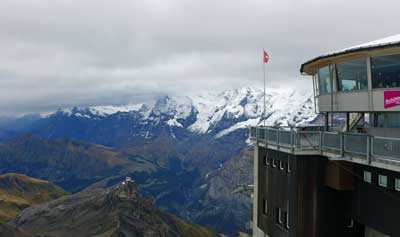
There is a rotating restaurant (with prices similar to normal Swiss restaurants) and a bizarre and anachronistic James Bond attraction based on it being a key location in the 1969 movie On Her Majesty’s Secret Service. The Bond thing is included with the lift, and it’s worth a look.
But the main thing you come here for is the 360-degree view from one of the highest peaks in Europe. Again, the weather here is key, but fortunately all the locals track the visibility on a minute-by-minute basis. If it’s clear up top while you are in the area, it would be a terrible shame to skip it based on the high price. But even if it’s cloudy up top, there are still plenty of wonderful things to see and do in the villages below.
Jungfraujoch observation area
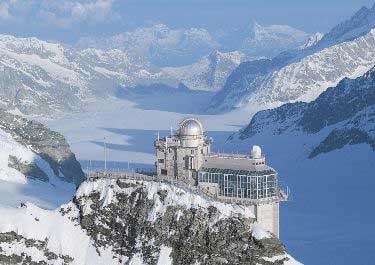
The views from the top are similar to the views from Schilthorn, from the other side of the Lauterbrunnen Valley. Once on top you can have lunch, hike, or even go sledding. It’s also quite expensive at nearly US$200 round-trip unless you have a Swiss Pass or a Eurail Pass for discounts, and it takes most of your day, but you’ll never forget the views from the top.
Harder Kulm mountain and Two Lakes Bridge Observation Deck
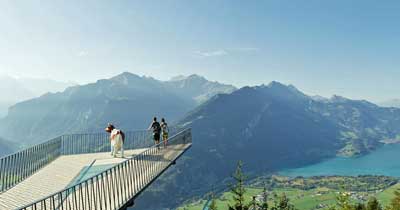
There’s a revolving restaurant about 10 minutes’ walk from the station at the top, which is definitely an unforgettable place for lunch if you’ve got time. It’s not as expensive as you might expect, at least compared to normal restaurants in Switzerland.
The Harder Kulm Railway goes from early April through late November each year. If you are only in Interlaken for one day and/or you are on a strict budget, this is the fastest and best way to get amazing Alpine views in the area.
Getting from Interlaken to Gimmelwald and Mürren
Getting up to these villages sounds complicated and time consuming, but it’s actually fast and easy once you get there. This little guide should help.
Arrive in Interlaken
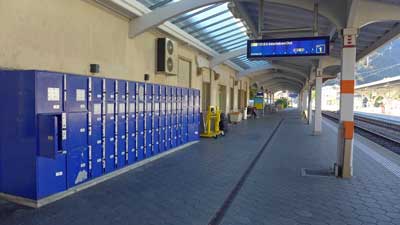
Once you arrive at the Interlaken Ost train station, head for the ticket windows in the office and buy a ticket to your final destination (Lauterbrunnen, Gimmelwald, or Mürren). Eurail passes are good for 25% discounts on the rest of the trip, but not for the whole thing.
From Interlaken Ost to Lauterbrunnen
The private train leaves Interlaken Ost every 30 minutes and arrives in Lauterbrunnen 20 minutes later. If you are staying in Lauterbrunnen then you are probably walking distance from your hotel when you reach the station.
From Lauterbrunnen to Gimmelwald
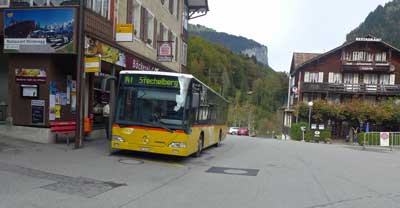
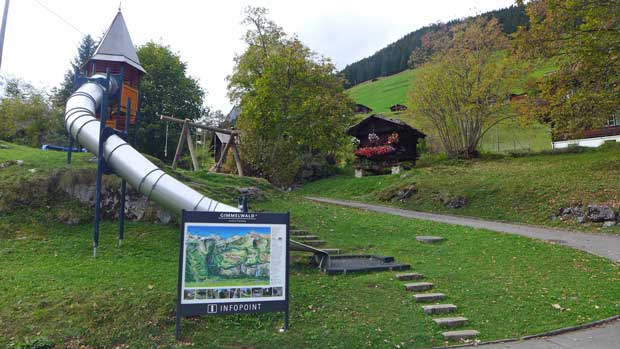
From
Gimmelwald to Mürren
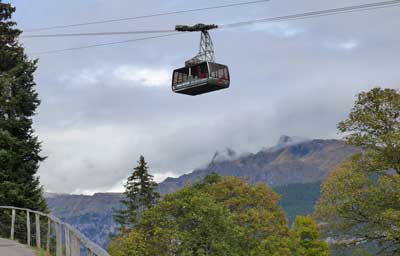
Recommended hotel and hostel in Gimmelwald
I get asked all the time about where to stay in Gimmelwald, so here it is:
Hotel: Esther’s Guesthouse
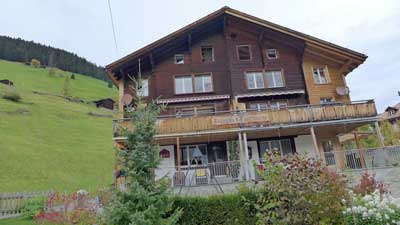
It’s run by Esther, as you might guess, and she is very friendly speaking excellent English. Each room is different and the place feels like a mountain cabin, because it is. She offers an excellent buffet breakfast in the morning, which you have to order the night before. It’s not cheap, but it’s worth it because it’s hearty and there are no other good options nearby.
Book as early as possible because this place is often the first place to sell out in Gimmelwald.
Hostel: Mountain Hostel Gimmelwald
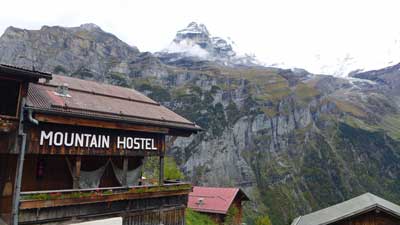
You won’t believe the views from this place, which are the same as from Esther’s except a bit lower and more unobstructed. This place also has a busy bar and restaurant that is basically the only “nightlife” in Gimmelwald. Many hikers get to bed early in this tiny village, but if you want to have a couple drinks and order a pizza or some local options, this is the place to go.
Again, book early because this place is always sold out.
Lucerne and what to do there
Luzern, as it’s spelled locally, is the other traditional holiday destination in Switzerland. Unlike Interlaken, Lucerne actually qualifies as a small city rather than a small resort town, so it’s a very nice contrast and very worthwhile.
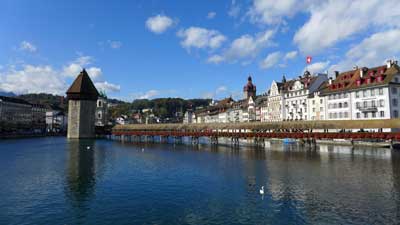
However, unlike Interlaken, the town of Lucerne itself is a great attraction and worth at least a day of exploration. This has always been a rich area so you can expect to find all of the high-end shops and boutiques along the small streets just north of the lake, but there are also many traditional shops and things to see that will appeal to anyone.
Recommended hotel in Lucerne
>>Hotel Des Alpes (3 stars with an amazing location and view)
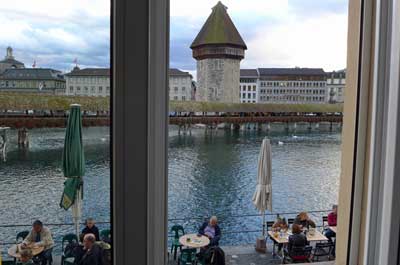
If this place is booked, which is often the case, then book a hotel as close to it as you can find or afford. The whole historic part of town surrounding it is lovely, with restaurants, bars, and high-end shops. There are also a couple of nearby supermarkets where you can buy inexpensive alcohol and picnic supplies to keep other costs down.
Spend a day in Lucerne itself
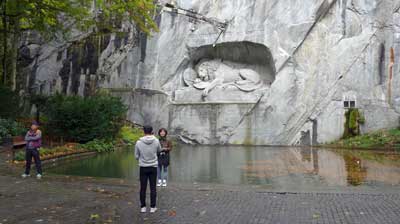
Most of the interesting part of Lucerne is in the area behind those restaurants, and it’s certainly worth doing a self-guided walking tour if not a guided one. Heading farther east you’ll come to another older part of town where the famous lion statue is located. You can’t visit Lucerne without having a look at the lion, and fortunately it’s easy and quick to reach (and it’s free).
Take a lake cruise of some kind
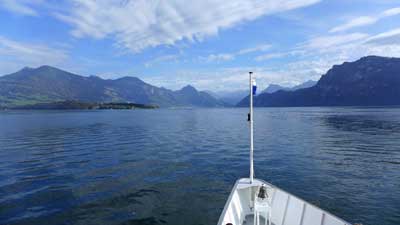
Especially in nice weather, even the short lake tour is lovely, and if you have more time you can jump off at Vitznau and do the scenic hike up Mount Rigi. There are also small lakeside villages that are ideal for a stroll and lunch stop. Long story short, there are dozens of interesting sightseeing options that are available using part of the boat tour, and the views all around are wonderful.
Visit Mount Pilatus
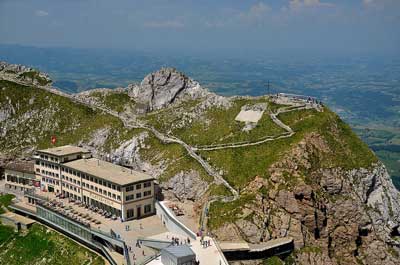
You can take the cogwheel train up and have a more or less flat hike around the summit area, and then take the gondola and cable car back down again. You can do them in the other order, and the cost is the same either way. At around US$65, this is not a cheap hike, but like most everything in Switzerland, the quality is high so it doesn’t feel like a rip-off. You can reach the cable car in 10 minutes on a public trolly bus from Lucerne.
Visit Mount Rigi
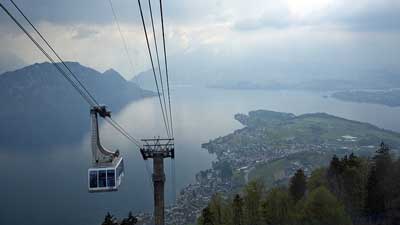
Unlike the other peaks mentioned in this article the Swiss Travel Pass covers both ways to get up and down for free. The others are 50% off with the Swiss Travel Pass or Half Fare Card, except for Jungfraujoch, which is only 25% off with the Swiss Travel Pass and still 50% off with the Half Fare Card.
Visit Mount Titlis
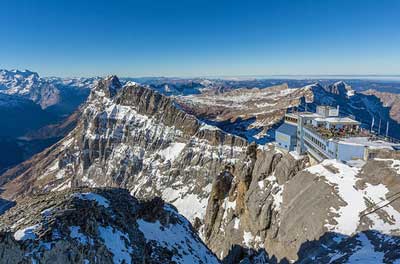
You can reach Titlis by taking a 43-minute train ride from Lucerne to Engelburg and then taking the cable car up from there. As with the others, it’s wise to check the weather immediately before you are going to depart because it can be foggy or cloudy any time of the year, but usually not for whole days at a time.
Additional photo credits
Jungfraujoch by cupweuro on Flickr, Pilatus by Tony Fernandez on Flickr, Rigi by Kosala Bandara on Flickr, Titlis by PaulSchliebs on Flickr

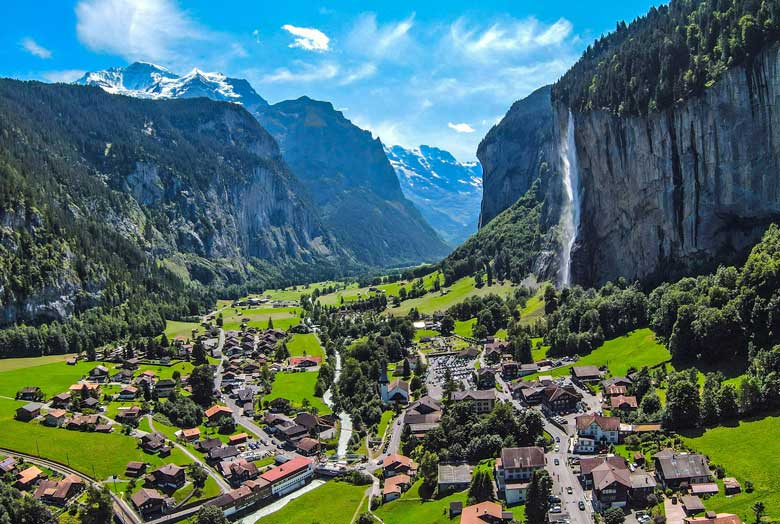
Hi there. So we are travelling to Switzerland in June with our family from Canada. What are the top 3 scenic train rides you would recommend for us? There are 10 of us and we have 2 Vans booked so we are good for transportation. We are just looking for scenic train rides that we can ride for a couple of hours. Thank you for your time.
Ali,
The best and most famous of the scenic train routes that have names are each 4 to 7 hours each way, so they aren’t ideal for just two hours at a time. The good news is that nearly every train ride in Switzerland is extremely scenic. What I’d recommend is to go to Interlaken and then take the short train ride to Lauterbrunnen and then take the cable car up Schilthorn and also take the train to Wengen from Lauterbrunnen. The Lauterbrunnen Valley is a fairly compact area next to Interlaken and it’s one of the most beautiful areas on earth. If you spend a few hours exploring that valley you’ll be amazed by the scenery without having to go across the country and back. -Roger
Thanks for your reply.
May be i got greedy and made the itinerary so busy 🙂
Here goes the revised one,
Sep 28 Sat – Arrival Zurich Airport ->
– do the Rigi Classic Round Trip:
– with the lake cruise and the cable car up and the train down
sep 29 Sun – Check-out Hotel and go to Interlaken by GoldenPass Line
– Relax and enjoy villages like gimmelwald/grindelwald/Lauterbrunnen
– Waterfalls like Staubbach Falls/Trummelbach Falls
– Overnight -> Gimmelwald/Murren/Wengen
Sep 30 Mon – Schilthorn excursion
– Kandersteg – Pipe ride -(Is it worth going ? )
– overnight STAY in Gimmelwald/Murren/Wengen
Oct 1 Tue – Interlaken To Milan -> Venice -> Escape with boat to Burano and Murano,Torcello islands and enjoy venice there -> overnight STAY
Oct 2 Wed – Venice/italy – afternoon to Slovenia (Avg 6 hours) -> overnight STAY
Oct 3 Thu – Slovenia – Morning -> Lake Bled,Vintgar Gorge, Savica Falls,Pericnik Falls(can hike up) + Kranjska Gora
afternoon -> Logar valley (Logarska dolina, valley -> dolina) beautiful for hiking trips
Oct 4 Fri – Morning – Hike in Triglav National Park,Soca(river rafting,valley)
Afternoon – tolmin Gorge + Tolmimska korita, Lake Bohinj -> STAY
Oct 5 Sat– Skocjan Caves -> head to Piran (overnight STAY) OR Rest Day / Else go to Croatia – STAY
Oct 6 sun– Explore Piran -> To Vienna / Explore Croatia -> Plitvice lakes national park, Dubrovnik/split – STAY
Oct 7 – Explore Vienna – STAY
Oct 8 Tue – Afternoon Fly Back to Bangalore from Vienna
Few questions :
1. Kandersteg – Pipe ride -(Is it worth going ? )
2. Considering this itinerary 3 days swiss pass would be good right?
3. Considering this itinerary, which would be the best stay for 2 nights Gimmelwald/Murren/Wengen?
4. Will Eurail be benefetial for the Venice,Slovenia,Croatia,Vienn a part?
Rajesh,
I haven’t done this Pipe Ride, but I did a similar one in New Zealand and I thought it was great.
Yes, I think a 3-day Swiss Travel Pass should work well and I think you’ll find even more things to use it on during those 3 days.
Each of those villages is lovely so it’s hard to choose. Gimmelwald is tiny and unlike any place you’ve ever seen or stayed. Similar to Gimmelwald, Murren is a car-free village just a bit up the mountain, and it’s got far more hotel and restaurant options along with slightly better views. Wengen does have a bit of car traffic, but it’s more central and better for nearby hikes.
For the non-Switzerland train rides it’s best to book them at least a month in advance and the fares will be pleasantly low. Actually, bus service in Croatia is better and cheaper than the train service and the trains don’t even go to Dubrovnik. Have a great trip. -Roger
Hi Roger,
thank you for the information. You forget to reply the number 2 answer. 🙂
Regards
unelma
Unelma,
Sorry about that, but it’s difficult to answer. Pilatus is the highest peak, Titlis has the most dramatic scenery, and Rigi is the most interesting trip because you can go up on a cable car and down on a mountain train. You’ll enjoy whichever you choose. -Roger
Hi Roger,
Your article is very much informative. Two of us are visiting Switzerland for 3 days in July. I have few questions to be clear.
Mostly we want to see alps and nature so our plan is to visit Lucerne and Interlaken.
1. Planning to stay in Lucerne do you think we need to divide our stay in two cities?
2. We want to go for hiking in one of these mountain pilautus ,titli or rigi which one do you recommend? I do not want to miss the best one.
3. Besides one of above we will thoroughly see rest of places in Lucerne,interlaken and zuric. Which swiss pass is better for us?
4. Will we have time to see Bern?
5. Do you think renting car is cheaper and faster?
regards
unelma
Unelma,
With only three days I’d recommend 2 days in the Interlaken area and one day in Lucerne. Honestly, the Lauterbrunnen Valley next to Interlaken has all of Switzerland’s best Alpine scenery and hikes and things to do. Lucerne is lovely and the town itself is nicer than the town of Interlaken, so it’s worth a day if you have it. Don’t bother with Zurich and I don’t think you’ll have enough time to visit Bern on this trip.
I’d highly recommend using trains in Switzerland instead of renting a car. The trains go everywhere you’ll want to go and if you get a Half Fare Card they are reasonably priced. That Half Fare Card will also get you 50% off all of the cable cars and mountain trains. Either way it will be expensive, but it’ll be worth it. Treat yourself to the trains and you’ll be glad you did. -Roger
My family is traveling to Switzerland and Italy. We are trying to figure out which euro pass to purchase.
We want to make first-class train reservations for the following travel throughout Switzerland and Italy from 7/20-8/2.
– (2) My wife and I plan on traveling around Switzerland from 7/21-7/26 (take a roundtrip train trip from Zurich to Lucerne/Interlaken/Zermatt with cablecar/train tours e.g Rhaetian, jubfrau, aletcsch glaciers..not sure if it is better to reserve a hotel+rail package or reserve hotels ourselves)
– (3) On 7/28 morning, our daughter will join us for a train ride from Zurich to Venice
– (3) On 7/30 morning, the 3 of us will take a train from Venice to Florence
– (3) On 8/1 morning, the 3 of us will take a train from Florence to Milan
1. Can you suggest which rail pass or tickets to purchase and any Switzerland rail tours (see above towns)?
2. If we don’t reserve a Switzerland rail tour and make our own hotel reservations, which rail pass/tickets should we purchase?
3. how can we reserve first class seats for Switzerland and Italy individual legs?
4. when should we purchase these passes/tickets?
5. I was recommended to visit Chamonix region instead of Zermatt..any comments?
Jeff,
It depends on just how many train rides and cable cars and boat rides you’d take in Switzerland, but from the looks of it the Swiss Travel Pass will be the best value. The 8-day version might even be best even if you aren’t using all 8 days because the per-day price is quite reasonable and you’ll get MUCH more value out of it. Or you could get a 4-day version and just plan all of your expensive rides during those 4 days. With that pass you don’t even need reservations on normal intercity trains. You can just hop on board and find seats and then show your pass to the ticket person as they come by. First class carriages are usually mostly empty, except for the early morning trains between the big business cities. You’ll need to reserve seats in the panoramic carriages on the scenic trains.
For international trains and those within Italy it’s best to buy as early as possible, since fares start out low and go up as more seats are sold. Those trains within Italy will be pretty cheap if you buy at least a month or two in advance.
I haven’t been to Chamonix, but I’ve also heard very good things. It may well be more impressive and I think the main reason so many people go to Zermatt is to be able to say they’ve visited the Matterhorn. If you don’t care so much about that I think Chamonix could be a better choice. Let me know if you have any other questions. -Roger
Hi Roger,
Hats off to your patience and detailed explanations for the previous answers. It helped a lot in understanding many details. I had prepared an itinerary as below. Please suggest your improvement points.
Sep 28 Sat – Arrival Zurich Airport -> transfer to Lucerne -> Mt. Rigi excursion, overnight STAY in Lucerne
sep 29 Sun – Excursion to Mt. Titlis (morning) -> Afternoon Schilthorn excursion, overnight STAY in Gimmelwald
Sep 30 Mon – Morning Jangfrau -> Afternoon explore area(laterbaun,Grindelwald,Stobach falls) night at Gimmelwald
Oct 1 Tue – Interlaken – Zweisimmen – Montreux (GoldenPass MOB Panoramic), 2.5 hrs.
Afternoon -> Montreux to zermatt -> 3 hours (overnight STAY)
Oct 2 Wed – Morning -> Zermatt – St. Moritz -> Glacier Express -> 8 h 03 min
Berlin express -> St. Moritz / Chur – Tirano (Italy) -> 3 h
Tirano -> Venice (overnight STAY)
Oct 3 Thu – Venice/italy -> Escape with boat to Burano and Murano,Torcello islands and enjoy venice there -> overnight STAY
Oct 4 Fri – Venice/italy – Slovenia (Avg 6 hours) -> overnight STAY
Oct 5 Sat– Slovenia – Morning -> Lake Bled,Vintgar Gorge, Savica Falls,Pericnik Falls(can hike up) + Kranjska Gora
afternoon -> Logar valley (Logarska dolina, valley -> dolina) beautiful for hiking trips
Oct 6 sun– Morning – Hike in Triglav National Park,Soca(river rafting,valley)
Afternoon – tolmin Gorge + Tolmimska korita, Lake Bohinj -> STAY at Ljubljana
Oct 7 – Consider Morning Logar valley
Afternoon -> Skocjan Caves,Postojna caves-> head to Piran (overnight STAY)
Oct 8 Tue – Explore Piran -> Eve -> Fly Back to Bangalore
Planning 4 days swiss pass( even-though +1 day is coming)
Included Montreux (GoldenPass MOB Panoramic) -> Zermatt – St. Moritz -> Glacier Express -> Berlin express -> St. Moritz / Chur – Tirano (Italy), so that all scenic routes can be covered. Will it be worth enough?? Else what would be the best option to get to Venice?
Rajesh,
I’ll try to go through this in order.
Doing Mt Titlis in the morning and then going all the way to Interlaken in time to go up Schilthorn that same day could be challenging. If you leave early enough in the morning it should be possible though. Your itinerary looks really busy, but also amazingly well planned out. I’m not sure you’ll have time for all of the things on some of those busy days, so it’s obviously best to start with the top things on your list and if you can’t make some of the others you’ll still have great days.
I do think the Swiss Travel Pass should work well for you, just as you’ve concluded. With Schilthorn and all those long train rides you should be getting really good value out of it. I don’t have anything else to say, but if you have specific questions let me know. Very well done so far and I’m sure you’ll have an amazing trip. -Roger
Hi Roger, we are intending to see some sights in Switzerland after our cruise which ends in Rome. My question would be, would it be better to have a base in Switzerland and visit some of the places you suggested on day trips by train. I was thinking of Zürich but am open to advice. We are intending to stay for about 3 to 6 days depending on the cost of accommodation, fares and sight seeing. Regards Norma from Australia.
Norma,
I’d use the Interlaken area as a base, mostly because it’s loaded with the best views and wonderful attractions so you will probably want to stay there most days. It’s probably best to stay in Interlaken for 3 days and then if you have enough time you can base yourself in Lucerne for up to 3 days. Zurich is pleasant enough for a big city, but honestly it’s extremely expensive and a bit boring, mostly being known for its banks. You get more for your money in hotels in Interlaken and Lucerne as well. Let me know if you have any other questions. -Roger
Hi Roger,
Thanks you so much for your wonderful post with so many great information. It was extremely informative. We are planning our trip based on your blog, and thanks so much for your kind patience in answering each blogger’s questions.
We are actually short on time for planning currently since we are going next month, but hope to get some advices from you. We have around a 10 day trip to Europe, will be traveling from Paris ? Frankfurt? Switzerland.
We have not bought the train tickets from Paris to Frankfurt, and Frankfurt to Interlaken yet, and we plan on spending 3 days in Switzerland.
Pls see below for the 6 numbered questions
1. Which pass would you recommend us getting, the Swiss Travel Pass or the Eurorail Pass (does Eurorail pass cover Frankfurt to Interlaken/Paris to Frankfurt train? Or the Half Fare Card? Or some kind of other pass/discount coupon? Or any pass at all? Do I have to book them ahead of time or can I just buy at the stations?
Our itinerary based on reading your blog will be:
Sun 6/16 – try to get an early train to traveling from Frankfurt to Interlaken, and stay at Gimmelwald (saw you recommended this one over Lauterbrunnen/Murren)
2. Will there be enough time left in that first day to go to Schilthorn? If not anything you recommend us do that afternoon/evening?
Mon 6/17– Will definitely at least do Schilthorn if we didn’t get to do it the previous day, and try to squeeze in Jungfraujoch as well in the same day if time allows, or just explore the area some more.
Stay a second night at Gimmewald
Tues 6/18 – Train to Lucerne
3. I can just find any train and it will be scenic right? Or is it a special one that we have to book via Golden Pass Express we have to search for)
4. Is it do-able to plan to squeeze Mt Rigi that day in the afternoon via a lake cruise
Stay the night at Lucern
Wed 6/19 – Visit Mount Pilatus
5. You don’t think we have time to do Mt Titlis as well do you, anything else you recommend over what we have planned?
Thu 6/20 – we have a 6AM flight out of Zurich
6. When do you think we will have to leave Lucern?
Thank you so much for your help. We just want to be able to maximize our schedule and hit as much as the highlight despite our short trip. Also needed your help to guide us financially on which pass purchase is most economically. Thanks!
TouristHW,
I’m glad this has helped and I will try to answer your questions in order. Although first off, are you planning on just traveling through Frankfurt? Or staying there for a few days? Frankfurt is famous for its airports and banks, but it’s not much of a tourist city at all. I discuss that and more on my article about where to go in Germany.
1. For the non-Swiss trains you’ll be best off buying the tickets as early as possible and not getting a pass. Within Switzerland you’ll probably be best off with a Half Fare Card based on the list of things you are planning, but a full Swiss Travel Pass might be even better depending on the specifics.
2. A train from Frankfurt to Gimmelwald will take a little over 6 hours and if you leave early enough you’d have time to go up Schilthorn (as long as the weather on top is clear). From Gimmelwald the cable car to Schilthorn takes less than an hour and it goes every 30 minutes.
3. It’s true that virtually every train ride in Switzerland (except for within Zurich) is very scenic. And the entire area around Lake Lucerne is extremely scenic, but I wouldn’t just hop on a train. I’d take the lake cruise and then do Mt. Rigi. Since that’s all covered by the Swiss Travel Pass (along with Schilthorn) it could make sense to buy the full pass for 3 days.
4. Again, as long as you start early you should have time to do a lake cruise and also up and down Mt. Rigi.
5. Each of the mountain peaks (Rigi, Titlis, Pilatus) take about half a day to enjoy. If you try to do two of them in the same day it will require starting early and rushing a bit. I prefer one per day. Pilatus on that full day should be great.
6. The Swiss trains start very early in the morning, but not quite early enough to reach Zurich Airport before 05:00. I’d take an evening train to the Zurich Airport area and check into one of the more affordable hotels that is very close and provides morning transport. Let me know if you have any other questions. -Roger
hi Roger, we are planning a weektrip in september flying into and out of Zurich. Right now we are looking at two nights in lucerne and two in gimmelwald. The vineyards outside of montreaux look interesting to us. Basically we want to experience the people, beauty and nature of Switzerland in a week. do you have any thoughts on the order of the trip, if we can function by a car or would train be better for the whole trip. Thanks
Lisa,
As I mention so often, two nights in the Interlaken area and two nights in Lucerne will give you the best and most amazing views and experiences in Switzerland in the shortest time. If you’ve got more days then I think exploring the Montreux area could be another fine stop, especially as the train from Lucerne to Interlaken and on to Montreux is essentially the famous Goldenpass scenic train line. I’d do it in that order since Lucerne is closest to Zurich and hopefully you’ll have enough time to get back to Zurich Airport by train on the day you fly out.
I’d definitely do it by train because the trains in Switzerland are great, famously punctual, and they go places cars don’t go. Also, renting a car and trying to follow the local highways and customs from one expensive parking area to the next can be stressful unless you’ve done it before. Depending on the attractions you plan on doing and the trains you plan on taking, you’ll probably want a Half Fare Card or a Swiss Travel Pass, which are discussed in detail at that link. Let me know if you have any other questions. -Roger
Hi Roger,
Great, thanks for all of your detailed advise,